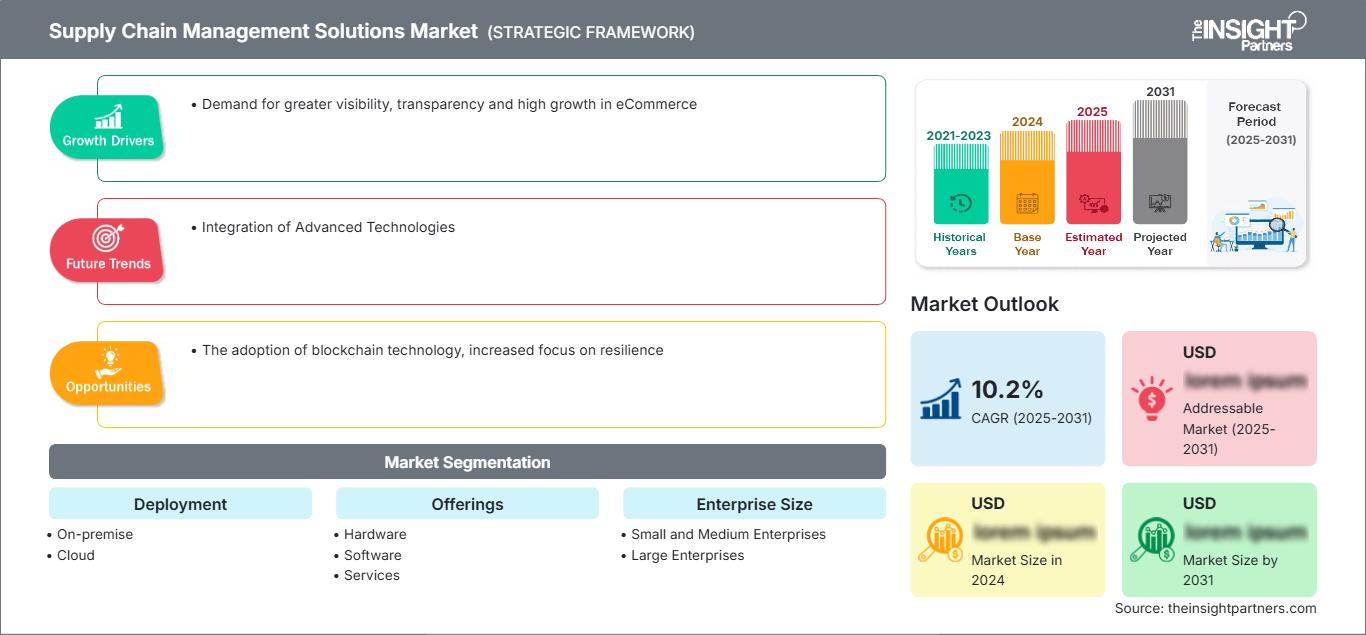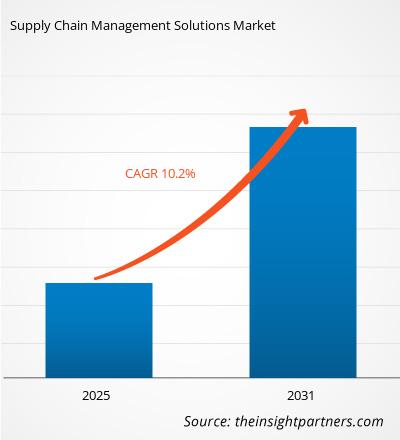Der Markt für Supply-Chain-Management-Lösungen wird zwischen 2023 und 2031 voraussichtlich eine durchschnittliche jährliche Wachstumsrate (CAGR) von 10,2 % verzeichnen. Die Einführung der Blockchain-Technologie und ein verstärkter Fokus auf Resilienz werden voraussichtlich weiterhin wichtige Markttrends bleiben.
Marktanalyse für Supply-Chain-Management-Lösungen
- Der Einsatz von Supply-Chain-Management-Lösungen nimmt weltweit rasant zu, da Unternehmen bestrebt sind, die Effizienz ihrer Betriebsabläufe und die Resilienz ihrer Lieferketten zu steigern.
- Dies ist hauptsächlich auf die zunehmende Nutzung cloudbasierter Systeme sowie fortschrittlicher Analyse- und Automatisierungstechnologien zurückzuführen, da Unternehmen versuchen, die Sicherheit und Funktionsfähigkeit ihrer Prozesse durch erhöhte Transparenz durch Daten zu verbessern.
- Dieser Wandel ist unter anderem eine Folge der pandemiebedingten Störungen, die die Notwendigkeit schneller Reaktionsmöglichkeiten deutlich gemacht haben. Angesichts der Notwendigkeit der digitalen Transformation signalisiert die Prognose einen langfristigen Marktboom für diese Lösungen.
Marktübersicht für Supply-Chain-Management-Lösungen
- Der Markt für Supply-Chain-Management-Lösungen erlebt seit Jahren ein exponentielles Wachstum. Der Markt ist Berichten zufolge.
- Der aktuelle Markt umfasst Management-Technologien wie Cloud-basierte Lösungen, erweiterte Analysen, Automatisierung, robotergestützte Prozessautomatisierung und vieles mehr. Diese Lösungen werden zunehmend in verschiedenen Sektoren wie Einzelhandel, Fertigung, Bauwesen, Lebensmittel und Getränke, Gesundheitswesen und mehr eingesetzt.
- In den kommenden Jahren wird der Bedarf an innovativen Supply-Chain-Management-Lösungen angesichts der zahlreichen Herausforderungen, vor denen Unternehmen weltweit stehen, exponentiell steigen.
Passen Sie diesen Bericht Ihren Anforderungen an
Sie erhalten kostenlos Anpassungen an jedem Bericht, einschließlich Teilen dieses Berichts oder einer Analyse auf Länderebene, eines Excel-Datenpakets sowie tolle Angebote und Rabatte für Start-ups und Universitäten.
Markt für Supply-Chain-Management-Lösungen: Strategische Einblicke

- Holen Sie sich die wichtigsten Markttrends aus diesem Bericht.Dieses KOSTENLOSE Beispiel umfasst Datenanalysen, die von Markttrends bis hin zu Schätzungen und Prognosen reichen.
Markttreiber und -chancen für Supply-Chain-Management-Lösungen: Nachfrage nach mehr Sichtbarkeit und Transparenz begünstigt den Markt
Sie erhalten kostenlos Anpassungen an jedem Bericht, einschließlich Teilen dieses Berichts oder einer Analyse auf Länderebene, eines Excel-Datenpakets sowie tolle Angebote und Rabatte für Start-ups und Universitäten.
Markt für Supply-Chain-Management-Lösungen: Strategische Einblicke

- Holen Sie sich die wichtigsten Markttrends aus diesem Bericht.Dieses KOSTENLOSE Beispiel umfasst Datenanalysen, die von Markttrends bis hin zu Schätzungen und Prognosen reichen.
- Die steigende Nachfrage nach Lieferkettentransparenz und verbesserter Transparenz war ein wesentlicher Faktor für das Wachstum des Marktes für Supply-Chain-Management-Lösungen.
- Unternehmen wissen heute, dass verbesserte Transparenz Managern hilft, Produktbewegungen, Lagerbestände und Lieferantenleistung in Echtzeit zu überwachen und so die richtigen Entscheidungen zum richtigen Zeitpunkt zu treffen.
- Transparenz hilft, Störungen und Ineffizienzen früher zu erkennen und Vertrauen bei den Stakeholdern aufzubauen, was letztendlich zu einer besseren Betriebseffizienz und Kundenzufriedenheit führt und somit den Gesamtwert des Unternehmens steigert.
- Da Unternehmen bestrebt sind, Lieferkettenrisiken zu reduzieren, die Betriebseffizienz und andere Faktoren zu verbessern, besteht ein zunehmender Bedarf an fortschrittlicheren Lösungen, die eine ganzheitliche Lieferkettentransparenz bieten und das Marktwachstum weiter ankurbeln.
Integration fortschrittlicher Technologien
- Im Laufe der Jahre haben technologische Fortschritte dem Markt für Supply-Chain-Management-Lösungen hervorragende Wachstumschancen eröffnet.
- Zum Beispiel der Einsatz von Technologien wie künstlicher Intelligenz (KI), Das Internet der Dinge (IoT) und fortschrittliche Datenanalysen zur intelligenten Überwachung, Bewertung und Analyse in Echtzeit sowie zur Vorhersage verschiedener Ereignisse in der Lieferkette ermöglichen es Unternehmen, das Lieferkettenmanagementsystem intelligent zu automatisieren und zu optimieren und so zeitnah und effektiv auf sich ändernde Trends und Kundenanforderungen zu reagieren.
- Mit der zunehmenden Akzeptanz dieser Technologien auf dem Markt zur Aufrechterhaltung einer effektiven Kontrolle über Lieferkettenabläufe wird erwartet, dass der Markt für Lieferkettenmanagementlösungen in den kommenden Jahren einen erheblichen Anstieg verzeichnen wird.
Segmentierungsanalyse des Marktberichts zu Lieferkettenmanagementlösungen
Schlüsselsegmente, die zur Ableitung der Marktanalyse für Lieferkettenmanagementlösungen beigetragen haben, sind Bereitstellung, Angebote, Unternehmensgröße und Branche.
- Basierend auf der Bereitstellung ist der Markt für Lieferkettenmanagementlösungen in On-Premise und Cloud unterteilt.
- Basierend auf den Angeboten ist der Markt für Lieferkettenmanagementlösungen in Hardware, Software und Services unterteilt.
- Basierend auf der Unternehmensgröße ist der Markt für Lieferkettenmanagementlösungen in kleine und mittlere Unternehmen (KMU) und große Unternehmen.
- Basierend auf der Branche ist der Markt für Supply-Chain-Management-Lösungen in die Bereiche Luft- und Raumfahrt und Verteidigung, Automobil, Elektronik, Lebensmittel und Getränke, Industrie, Gesundheitswesen, Transport und Logistik und andere unterteilt.
Marktanteilsanalyse für Supply-Chain-Management-Lösungen nach Geografie
- Der Marktbericht für Supply-Chain-Management-Lösungen umfasst eine detaillierte Analyse von fünf großen geografischen Regionen, einschließlich der aktuellen und historischen Marktgröße und Prognosen für 2021 bis 2031, und deckt Nordamerika, Europa, Asien-Pazifik (APAC), Naher Osten und Afrika (MEA) sowie Süd- und Mittelamerika ab.
- Jede Region ist weiter in die jeweiligen Länder unterteilt. Dieser Bericht bietet Analysen und Prognosen für mehr als 18 Länder und deckt die Marktdynamik von Supply-Chain-Management-Lösungen ab, wie etwa Treiber, Trends und Chancen, die die Märkte auf regionaler Ebene beeinflussen.
- Darüber hinaus umfasst der Bericht eine PEST-Analyse, die die Untersuchung der wichtigsten Faktoren umfasst, die den Markt für Supply-Chain-Management-Lösungen in diesen Regionen beeinflussen.
Markt für Supply-Chain-Management-Lösungen
Die Analysten von The Insight Partners haben die regionalen Trends und Faktoren, die den Markt für Supply-Chain-Management-Lösungen im Prognosezeitraum beeinflussen, ausführlich erläutert. In diesem Abschnitt werden auch die Marktsegmente und die geografische Lage in Nordamerika, Europa, dem asiatisch-pazifischen Raum, dem Nahen Osten und Afrika sowie Süd- und Mittelamerika erörtert.Umfang des Marktberichts zu Supply-Chain-Management-Lösungen
| Berichtsattribut | Einzelheiten |
|---|---|
| Marktgröße in 2024 | US$ XX million |
| Marktgröße nach 2031 | US$ XX Million |
| Globale CAGR (2025 - 2031) | 10.2% |
| Historische Daten | 2021-2023 |
| Prognosezeitraum | 2025-2031 |
| Abgedeckte Segmente |
By Bereitstellung
|
| Abgedeckte Regionen und Länder | Nordamerika
|
| Marktführer und wichtige Unternehmensprofile |
|
Dichte der Marktteilnehmer für Supply-Chain-Management-Lösungen: Verständnis ihrer Auswirkungen auf die Geschäftsdynamik
Der Markt für Supply-Chain-Management-Lösungen wächst rasant. Dies wird durch die steigende Endverbrauchernachfrage aufgrund veränderter Verbraucherpräferenzen, technologischer Fortschritte und eines stärkeren Bewusstseins für die Produktvorteile vorangetrieben. Mit der steigenden Nachfrage erweitern Unternehmen ihr Angebot, entwickeln Innovationen, um den Bedürfnissen der Verbraucher gerecht zu werden, und nutzen neue Trends, was das Marktwachstum weiter ankurbelt.
- Holen Sie sich die Markt für Supply-Chain-Management-Lösungen Übersicht der wichtigsten Akteure
Der Markt für Supply-Chain-Management-Lösungen wird durch die Erhebung qualitativer und quantitativer Daten nach Primär- und Sekundärforschung bewertet, die wichtige Unternehmenspublikationen, Verbandsdaten und Datenbanken umfasst. Einige der Entwicklungen auf dem Markt für Supply-Chain-Management-Lösungen sind nachfolgend aufgeführt:
- Sphera, ein führender Anbieter von Software, Daten und Beratungsdienstleistungen für ESG-Performance- und Risikomanagement, hat die Übernahme von Supply Shift bekannt gegeben, einem Unternehmen für Nachhaltigkeitssoftware für Lieferketten, das dafür bekannt ist, Unternehmen beim Aufbau transparenter, verantwortungsvoller und widerstandsfähiger Lieferketten zu unterstützen. (Quelle: Sphera, Pressemitteilung, Januar 2024)
Bericht zum Markt für Supply-Chain-Management-Lösungen: Umfang und Ergebnisse
Der „Markt für Supply-Chain-Management-Lösungen – Größe und Prognose (2021–2031)“ Der Bericht bietet eine detaillierte Analyse des Marktes und deckt die folgenden Bereiche ab:
- Marktgröße und Prognose für Supply-Chain-Management-Lösungen auf globaler, regionaler und Länderebene für alle abgedeckten wichtigen Marktsegmente
- Markttrends und Marktdynamiken für Supply-Chain-Management-Lösungen wie Treiber, Einschränkungen und wichtige Chancen
- Detaillierte PEST/Porters Five Forces- und SWOT-Analyse
- Marktanalyse für Supply-Chain-Management-Lösungen mit wichtigen Markttrends, globalen und regionalen Rahmenbedingungen, wichtigen Akteuren, Vorschriften und aktuellen Marktentwicklungen
- Branchenlandschaft und Wettbewerbsanalyse mit Marktkonzentration, Heatmap-Analyse, prominenten Akteuren und aktuellen Entwicklungen für den Markt für Supply-Chain-Management-Lösungen
- Detaillierte Unternehmensprofile
- Historische Analyse (2 Jahre), Basisjahr, Prognose (7 Jahre) mit CAGR
- PEST- und SWOT-Analyse
- Marktgröße Wert/Volumen – Global, Regional, Land
- Branchen- und Wettbewerbslandschaft
- Excel-Datensatz
Aktuelle Berichte
Verwandte Berichte
Erfahrungsberichte
Grund zum Kauf
- Fundierte Entscheidungsfindung
- Marktdynamik verstehen
- Wettbewerbsanalyse
- Kundeneinblicke
- Marktprognosen
- Risikominimierung
- Strategische Planung
- Investitionsbegründung
- Identifizierung neuer Märkte
- Verbesserung von Marketingstrategien
- Steigerung der Betriebseffizienz
- Anpassung an regulatorische Trends




















 Kostenlose Probe anfordern für - Markt für Supply-Chain-Management-Lösungen
Kostenlose Probe anfordern für - Markt für Supply-Chain-Management-Lösungen